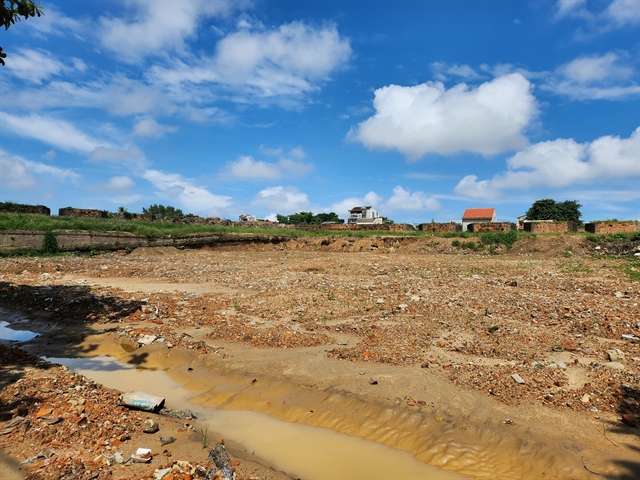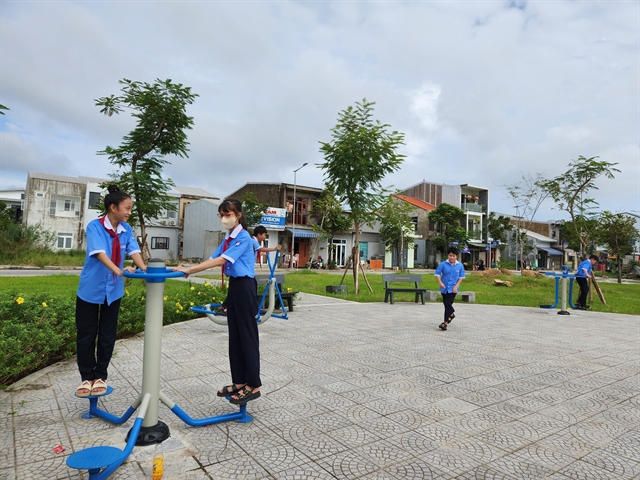 |
| New houses for residents at Hương Sơ Ward’s Resettlement Area in Huế City, in the coastal province of Thừa Thiên-Huế. — VNA/VNS Photo Tường Vi |
THỪA THIÊN-HUẾ — Lê Viết Cao Nguyên, 57, of residential group No. 3 in Hương Sơ Ward’s Resettlement Area in Huế City, and his wife are preparing tables and chairs to welcome customers to their iced tea shop.
Nguyên said: “This is something that we could never have done four years ago in our 32sq.m old house in Thuận Lộc District belonging to the Huế Citadel’s Area No. 1.”
The old house was not big enough for his seven-member family, he said.
“We didn’t even have enough space to set up a set of table and chairs to sit down,” he added.
Now they feel very grateful because they are living in a new and larger house in the resettlement area. The new house was large so they have opened an iced tea shop in their yard to earn more money to cover their daily life, he said.
Nguyên’s family was among over 5,000 households, who lived on relic land of Huế Citadel Monuments’ Area No.1, belonging to the Complex of Huế Monuments in the central coastal province of Thừa Thiên-Huế, that were evacuated to the resettlement area in 2019.
The evacuation was implemented following the first phase of the project “Relocating residents and clearing land for the Area No. 1 of Huế Citadel Monuments, belonging to the Complex of Huế Monuments”.
The evacuation of local residents opened a new page of life for thousands of people and brought a new look to the city.
Not far from Nguyên’s house lives Lê Viết Thiện, head of the residential group, who was one of the first people to agree with evacuation plans.
“I found it is the most important and wisest decision of my life,” he said.
According to Thiện, owning a spacious house, which had a playground for grandchildren to enjoy, was like winning the jackpot.
In addition to giving residents new houses, the administration also created favourable conditions for them to borrow money to do business. More than 300 households in the residential group very welcomed the relocation policy of the State.
The Complex of Huế Monuments was recognised by the United Nations Educational, Scientific and Cultural Organisation (UNESCO) as a World Cultural Heritage since 1993.
Relocating local people out of the relic area and returning the intact value of the heritage are tasks that have long been set by the provincial administration.
With support from the Party and State, the first phase of the project has been successful.
The evacuation has brought a new look to the space of Huế Citadel, speeding up the process of preserving and restoring relics in the Complex of Huế Monuments.
This is also an important milestone demonstrating Việt Nam’s strong international commitment to preserving heritage after 30 years, since UNESCO recognised the Huế Monuments Complex as a World Cultural Heritage.
 |
| Area No 1 after the evacuation in the project’s first phase. — VNA/VNS Photo Tường Vi |
After the first phase was finished, the People’s Committee of the city mobilised human resources, machinery and vehicles to demolish temporary houses as well as clean up waste and weeds.
The area of Upper Citadel, Eo Bầu, Hộ Thành Hào and Phòng Lộ Route, which were desolate and unkempt in the past, are now airy and clean.
Some large-scale military projects of the Nguyễn Dynasty are gradually being revealed after decades of encroachment and impact by local people.
Initially, some areas have been exploited for tourism during the process of beautifying the monuments.
The city’s Land Fund Development Centre has planted many trees in Eo Bầu area in Nam Xương Fortress and Nam Thắng Fortress, and used the area as a parking lot for tourists.
Recently, the walking route on the Upper Citadel from Eo Bầu area in Nam Xương Fortress and Nam Thắng Fortress, passing the Huế Flag Tower, has opened, bringing visitors new experiences on the journey to explore the Huế Citadel from above.
Permanent Deputy Secretary of the provincial Party Committee Phan Ngọc Thọ said thanks to the consensus of local people, the first phase of the project had been finished and returned the heritage site’s value.
It was also the basis for the successful implementation of the second phase. The journey would be an important step, a historical milestone in the development orientation of Thừa Thiên-Huế to become an urban area of “Heritage, culture, ecology, environmentally friendly and smart landscape” that was realised by the authorities and local people, he said.
Second phase’ project
 |
| A playground at Hương Sơ Ward’s Resettlement Area in Huế City. — VNA/VNS Photo Tường Vi |
Currently, the province has taken procedures to approve the second phase of the project.
Under the Resolution No. 80/NQ-HĐND, issued on August 21, 2023, the second phase will evacuate 1,287 households in 19 relic areas of Hổ Quyền, Voi Ré, Thiên Mụ Pagoda, Văn Miếu – Võ Miếu, Nam Giao Esplanade, Minh Mạng Tomb, Thiệu Trị Tomb, Tự Đức Tomb, Dục Đức Tomb, Đồng Khánh Tomb, Khải Định Tomb, Gia Long Tomb, Trường Cơ Tomb, Cơ Thánh Tomb, Hòn Chén Temple, Hải Thành Fortress, Vạn Vạn Tomb, Âm Hồn Pavilion and Temple of Literature.
The total investment in site clearance is estimated to be about VNĐ664 billion (US$27.3 million).
The resettlement area, worth about VNĐ163 billion ($6.7 million) for the households, will cover more than nine hectares in the north of Hương Sơ Ward in the city.
The implementation of the project’s second phase will help the province fundamentally solve the problem of relocating people living in areas of the Complex of Huế Monuments.
Currently, An Lăng relic campus, the resting place of three Nguyễn Dynasty’s Kings of Dục Đức, Thành Thái and Duy Tân with the queen and dozens of royal descendants, currently is the place where more than 30 households still reside.
More than 40 years ago, the local administration provided accommodations for a number of officials from local departments and sectors in the area.
The houses have been seriously degraded but the owners cannot repair or re-build because the houses were located in the relic land.
For many years, local people have demanded on relocating and resettling to stabilise their lives.
Hoàng Văn Phỉ, a retired officer of a local agency, said in 1980, the agency arranged a 30sq.m house in the area near Dục Đức Tomb for him to live.
Now, his five-member family still lived together in the dilapidated house, he said.
“I hope to be evacuated to a new house, that is enough large for five people, in a resettlement area,” he said.
Deputy Director of the city’s Land Fund Development Centre Đặng Minh Thắng said that the provincial People’s Committee had submitted Report No. 11315/TTr-UBND on October 20 to the Ministry of Natural Resources and Environment requesting to expand the scope of the policy on compensation, support and resettlement to implement the project in the second phase.
After the ministry issued a written verification, which was approved by the Prime Minister, the centre would implement the project’s second phase in 2024-25.
Nguyễn Văn Phúc, director of the provincial Culture, Sports and Tourism Department, said that the clearance and relocation of residents living in the relic areas would create a new space for the Complex of Huế Monuments and diversify tourism products, services, and destinations associated with the Nguyễn Dynasty.
Along with promoting traditional forms of tourism associated with heritage and culture, the tourism sector would launch new products such as marathon running to experience heritage roads, cultural and art-related activities and night services in the Huế Imperial City, he said. — VNS
- Reduce Hair Loss with PURA D’OR Gold Label Shampoo
- Castor Oil Has Made a “Huge” Difference With Hair and Brow Growth
- Excessive hair loss in men: Signs of illness that cannot be subjective
- Dịch Vụ SEO Website ở Los Angeles, CA: đưa trang web doanh nghiệp bạn lên top Google
- Nails Salon Sierra Madre
 VnExpress News The News Gateway of Vietnam
VnExpress News The News Gateway of Vietnam





